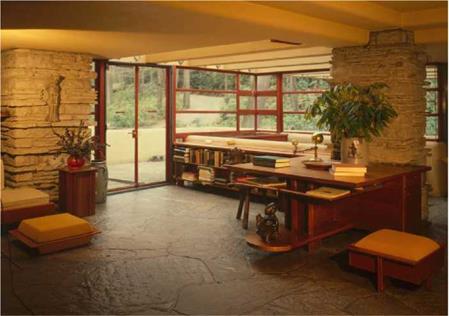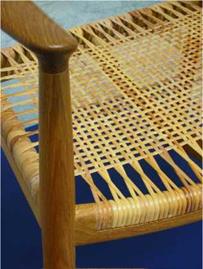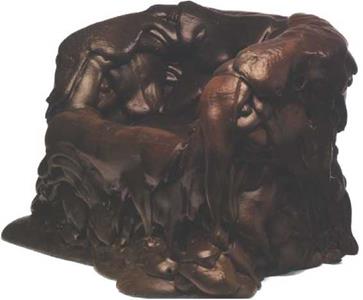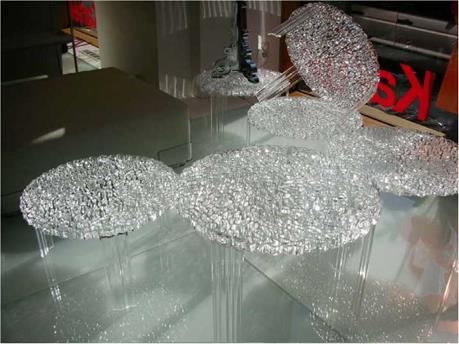Where do architects and designers get their ideas? The answer, of course, is mainly from other architects and designers.19
Paradigms indicate and underpin general perceptions and assumptions about a subject held by a specific group of people. Architects, interior designers, industrial designers, engineers, and fine artists approach furniture design from different perspectives (Figure 6.67). Traditionally, architects and interior designers work to emphasize a "sense of place." Emphasis is placed on the selection and location of custom furniture for a specific site. The architect works to create spatial, material, and ornamental correlations between a building and its furnishings. Furniture includes an enormous range of site-specific, mass-produced, built-in, and freestanding pieces. Furniture designed by architects and interior designers often complements the materials, details, and fabrication technologies of a building and its interior spaces. These furnishings generally are fabricated in limited runs and designed for specific spaces within a building.
An industrial designer is trained to focus on human factors and industrial processes throughout the development of design. Industrial designers are professionally invested in designing mass-produced work. Though architects incorporate mass-produced elements in their designs, architecture itself does not embrace the notion of being mass-produceable because of the unique characteristics of a place. The notion of place distinguishes the two fields in significant ways. Architects such as Frank Lloyd Wright, Charles Rennie Mackintosh, Ludwig Mies van der Rohe, and Alvar Aalto conceived, developed, and fabricated furniture for specific interior spaces and building environments. The mass production of their furniture designs for public consumption came later and is another story altogether.
Furniture designed for mass production is independent of specific architectural environments in both form and material. This establishes an independence of furniture from its
 |
 |
surrounding environment and advances the notion of furniture’s detachment from an architectural frame of reference. The differences between the professions are significant and directly impact the approach to furniture design, the design process, fabrication, and the delivery of products to the market.
Frank Lloyd Wright is renowned not only for his architecture but also for his furniture, which he designed for nearly every one of his 300 building projects. Some of these furnishings have been mass produced by various companies for the open market. The furnishings and built-ins that Frank Lloyd Wright designed throughout his career extend the details, material properties, and geometric motifs of the spaces for which they were designed. Where his buildings have been preserved, such as Fallingwater in rural Bear Run, Pennsylvania, the furnishings have also been carefully restored or replicated whenever possible (Figure 6.68).
|
Figure 6.68 Interior of Fallingwater (Edgar J. Kaufmann House), Bear Run, Pennsylvania, designed by Frank Lloyd Wright (1936). Historic American Buildings Survey. Photography by Jack E. Boucher, 1985. |
Individuals who have designed furniture primarily within the disciplinary boundary of architecture include Robert Adam, Alvar Aalto, Gae Aulenti, Mario Bellini, Harry Bertoia, Pierre Chareau, Joe Colombo, Le Corbusier, Peter Danko, Michele De Lucchi, Tom Dixon, Charles and Ray Eames, Piero Fornasetti, Frank Gehry, Michael Graves, Eileen Gray, George Hepplewhite, Hans Hollein, Arne Jacobsen, Finn Juhl, Vladimir Kagan, Poul Kjaerholm, Florence Knoll, Raymond Loewy, Vico Magistretti, Alessandro Mendini, Carlo Mollino, Morris and Co., George Nelson, Isamu Noguchi, Gio Ponte, Jim Postell, Jean Prouve, Ludwig Mies Van Der Rohe, Eero Saarinen, Ettore Sottsass, Robert Venturi, and Frank Lloyd Wright.
However, a majority of contemporary furniture designs, developed by industrial designers including Achille Castiglioni, Paolo Favaretto, Emiliano Godoy, Karim Rashid, and Bill Stumpf, were conceived and fabricated as solutions to lifestyle issues, are considered technical inventions, or result from explorations of material and manufacturing processes. Their work was not conceived for, nor was it dependent on, a particular interior or architectural environment. Furnishings such as these find their way to a variety of spaces and are sold directly to the public through retail, Internet, and catalog venues or through showrooms and furniture representatives directly to architects and interior designers who specify furniture as contract furnishings.
The Kite chairs (Figure 6.69) designed by Karim Rashid and the luta chair (Figure 6.70) designed by Antonio Citterio and manufactured by B & B Italia are examples of industrial products that have broad appeal for a wide range of interior spaces, conceived and manufactured within the framework of an industrial design typology.
Individuals who have designed furniture primarily within the disciplinary boundary of industrial design include: Eero Aarnio, Franco Albini, Emillio Ambaz, Ron Arad, Fred Baier, Boris Berlin, Harry Bertoia, Mattia Bonetti, Osvaldo Borsani, Achille Castiglioni, Franco Cavatorta, Erling Christoffersen, Robin Day, Peter Danko, Michele De Lucchi, Tom Dixon, Charles and Ray Eames, Piero Fornasetti, Elisabeth Garouste, Emiliano Godoy, Yoshiharu
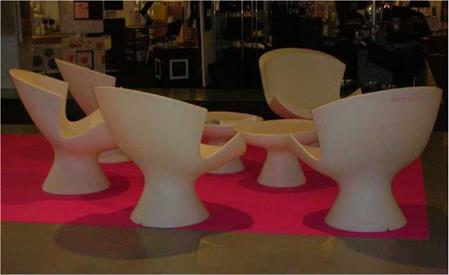 Figure 6.69 Rotary-molded Kite chairs, designed by Karim Rashid (2004), manufactured by Label. Photography by Jim Postell, 2006.
Figure 6.69 Rotary-molded Kite chairs, designed by Karim Rashid (2004), manufactured by Label. Photography by Jim Postell, 2006.
![]()
Hatano, Robert Heritage, Hans Hollein, Vladimir Kagan, Rodney Kinsman, Toshiyuki Kita, Poul Kjaerholm, Shiro Kuramata, Danny Lane, Estelle and Erwine Laverne, Raymond Loewy, Carlo Mollino, Morris and Co., Oliver Mourgue, Wolfgang Mueller Deizig, Peter Murdoch, Mark Newson, Isamu Noguchi, Verner Panton, Pierre Paulin, Gaetano Pesce, Warren Platner,
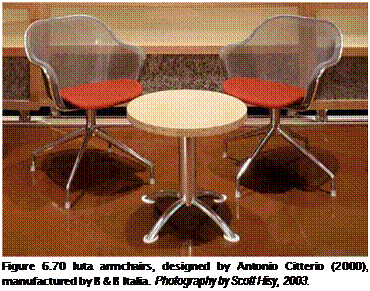 Ernest Race, Gordon Russell, Richard Sapper, Fred Scoott, Peter Shire, Borek Sipek, Philippe Starck, Bill Stumpf, Martin Szekely, Floris Van den Broecke, David Truebridge, Tappio Wirkkala, Sori Yanagi, and Marco Zanuso.
Ernest Race, Gordon Russell, Richard Sapper, Fred Scoott, Peter Shire, Borek Sipek, Philippe Starck, Bill Stumpf, Martin Szekely, Floris Van den Broecke, David Truebridge, Tappio Wirkkala, Sori Yanagi, and Marco Zanuso.
An interior designer is trained to think about furniture design similarly to an architect but differently than an industrial designer. Interior designers are primarily concerned with selecting furniture for their interiors. They generally focus upon interior aesthetics, contextual appropriateness, utility, comfort, form, finish, and product availability. Although purpose, comfort, and aesthetics are primary considerations for selecting furniture, the act of designing custom furniture for specific interiors has roots extending back to the eighteenth century The work of Thomas Chippendale and George Hepplewhite, along with that of designers such as Robert Adam and Elsie de Wolfe, were precursors of what today is called interior design. Contemporary interior designers practice furniture design by offering a distinct "look" that doesn’t yet appear in the catalogs. Their designs can influence change in the market when their lines successfully fill a niche overlooked by other designers. Florence Knoll (Knoll International) did just that.
Individuals who have designed furniture primarily within the disciplinary boundary of interior design include: Florence Knoll, Eileen Gray, Andrea Putnam, John Saladino, and Joe d’Urso.
Though interior designers design furniture, most are not trained to design within the tolerances required for mass production. Furthermore, few architects and interior designers are trained to think about industrial processes as industrial designers are.
Engineers are trained to focus on mechanical function and address the efficiency and material quality of performance-based function. Filing cabinets and adjustable office seating are examples of engineered objects that demand a high degree of technological resolution due to the tight tolerances between design and form as well as between fabrication and function. It is not surprising to see engineers focus on mechanical aspects and less on the spatial and contextual relationships between furniture and interior environments.
Individuals who have designed furniture primarily within the disciplinary boundary of mechanical engineering include: Egon BrQning, head of product development, Vitra; and Kurt Heidman, chief engineer, Steelcase.
Sociologists generally have a different perspective on furniture design than architects, designers, or craftspeople. Although sociologists don’t usually design furniture, they are taught to observe interpersonal and behavioral patterns among individuals, analyzing how people gather and interact socially within public areas, reception spaces, office settings, and so on. Edward T. Hall’s The Hidden Dimension and psychologist Robert Sommer’s Personal Space explore the concept of proxemics in depth. Their writings and ideas have influenced a generation of designers.
Craftspeople and woodworkers focus on the human skill of making and the visual and tactile quality of the overall finish of furniture. Craftspeople typically focus upon the properties of materials and fabrication methods, emphasizing workmanship and the making of furniture. It is in the making that they seek to master the craft of joining or to perfect a technique for finishing. Wendell Castle, Donald Judd, David Pye, Ernest Joyce, John Makepeace, George Nakashima, Sam Maloof, and Chris Simpson have written about furniture design from this perspective, and through their built work and writing, each has contributed to a body of knowledge concerning material, fabrication methods, and craft.
Architects, industrial designers, interior designers, furniture designers, artists, engineers, fabricators, craftspeople, theorists, sociologists, cultural anthropologists, historians, and business entrepreneurs actively contribute to furniture design in unique ways and hold distinct views about furniture. The sociologist and the cultural anthropologist represent one point of view and the interior designer and architect another. The industrial designer and product engineer provide yet another, and the craftsperson and artist represent a fourth perspective in forming thoughts about design and how they interrelate with the discipline of furniture design.
ENDNOTES
1. Carol Soucek King, Furniture—Architects and Designers Originals (New York: PBC International, 1994), p. 136.
2. Joy Malnar and Frank Vodverka, The Interior Dimension (New York: Van Nostrand Reinhold, 1992), pp. 29, 30-31.
3. The American Heritage Dictionary of the English Language, 4th edition (Boston, MA: Houghton Mifflin Company, 2000).
4. Cynthia Leibrock, Beautiful Barrier-Free A Visual Guide to Accessibility (New York: Van Nostrand Reinhold, 1993), p. 82.
5. Ernst von Weizacker, Amory B Lovins, and L Hunter Lovins, Factor Four: Doubling Wealth, Halving Resource Use. The New Report to the Club of Rome (London: Earthscan, 1997).
6. Interview with Jeff Arnold, May 2006, manager of Paxton Wood Crafters, Cincinnati, Ohio, about international forest certification programs.
7. Ibid.
8. Text description given to the author by Emiliano Godoy, June 2006.
9. Martin Charter and Ursula Tischner, Sustainable Solutions Developing Products and Services for the Future (Sheffield, UK: Greenleaf Publishing, 1991), Ch. 24.
10. Ron Mace, Universal Design: Housing for the Lifespan of All People (Washington, DC: U. S. Department of Housing and Urban Development, 1988).
11. Product design is defined as "the activity in which ideas and needs are given physical form, initially as solution concepts and then as a specific configuration or arrangement of elements, materials and components." V. Walsh, R. Roy, and Bruce M. Winning, By Design: Technology, Product Design and International Competitiveness (Basel: Blackwell, Oxford, 1992), p. 18.
12. www. malvino. com/intuitiv. htm; quote by Albert Einstein.
13. AIA Document D200 1995, "Project Checklist." This document contains a description of architectural design phases, which is also contained in Article 2.4 of AIA Document B141, 1997, "Standard Form of Agreement Between Owner and Architect with Standard Form of Architect’s Services."
14. Ibid.
15. Ibid.
16. www. brainyquote. com/quotes/quotes/l/ludwigmies101419.html. Van der Rohe is famous for his poetic aphorism, "God is in the details."
17. Ibid. (design phases).
18. Ibid. (design phases).
19. Stephen Bayley (British design critic), Commerce and Culture, From Pre-Industrial Art in PostIndustrial Value (a design museum book) (London: Fourth Estate Publishers, 1989) Chapter 3.
Matter is the material of design. Consider the self-expanding polyurethane foam Anti-object armchair, fabricated using pails of resin by Gunnar Aagaard Andersen (19191982) in 1964 (Figure 7.1), or the hand-woven cane seat pan in The Chair, designed by Hans J. Wegner (Figure 7.2), and hand-crafted in Johannes Hansen’s workshop in 1949. It would be a challenge not to acknowledge the influence that materials and craftsmanship had in the design and fabrication of these furnishings.
|
|
|
|
|
Figure 7.3 Vacuum-molded studies— DIS student furniture projects displayed at the International Furniture Fair in Copenhagen, 2006. Photography by Jim Postell, 2006. |
|
Figure 7.4 Plastic T-tables, designed by Patricia Urquiola (2006), manufactured by Kartell. Photography by Jim Postell, 2006. |
In The Material of Invention, Ezio Manzini takes a philosophical approach to the science of material. Professor Manzini is specific about the physical properties of material and thoughtful regarding how materials can influence design thinking. He presents the argument that material and technology drive innovative design by examining the relationships between matter and material (i. e., how material and its physical properties are an integral part of the process of transforming ideas into furniture). What was once considered impossible to make (let alone design) has become increasingly more possible to realize through evolving technology.
It is assumed that during prehistoric times, "furniture" was constructed from readily available natural materials and worked by hand into useful objects. As time progressed, materials were categorized, selected, and, in some regards, harvested and synthesized. Metals were combined to form alloys. Recently, materials have been designed at the molecular level (i. e., polymers), and from those efforts, nanotechnologies have emerged as a means to create biomaterials, many of which are biodegradable. Today, the technology is available to design and make almost anything. Scientific investigations have led to moleculesized machines, extraordinarily sensitive sensors, and revolutionary manufacturing and finishing methods.
Furniture designers do not need to understand the particulars of molecular science and nanotechnologies, or know the biomaterials currently available, but they do need to appreciate the distinction between matter and material. More important, designers need to understand why one material is better or more appropriate than another for a given situation. They should be informed about the newest materials and have a working knowledge of material properties. Doing so may help them conceive and develop better furniture designs.
Materials and how they are used in design contribute significantly to the structural integrity, comfort, and aesthetics of furniture. Considering the properties and characteristics of materials early in the conception of design focuses the designer’s thinking on the limits and constraints of materials, which, ironically, opens the door to creative design ideas.
Today, material research focuses on environmental issues, physical properties, health – related concerns, and performance-related characteristics. Digital design and fabrication technologies, along with new synthetic materials, have an enormous potential to influence the field of furniture design.

